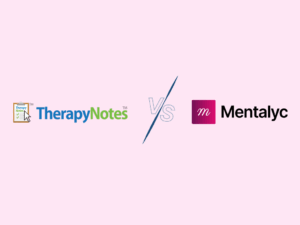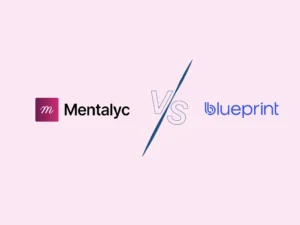Have you ever stared at a blank screen, wondering how to even begin a new client’s biopsychosocial (BPS) assessment? You’re not alone. Many therapists across the U.S. say that this report is the single most overwhelming piece of clinical documentation. Unlike progress notes such as GIRP or SOAP notes, which are brief and tied to one session, BPS assessments demand a far deeper dive. They’re lengthier, cover a client’s entire life story and family history, and often feel emotionally weighty to write.
Biopsychosocial Assessment vs. Other Notes
| Feature | Biopsychosocial Assessment | SOAP Notes | DAP Notes | Progress Notes |
| Purpose | Provides a comprehensive evaluation of biological, psychological, and social factors influencing a client | Focuses on documenting session data, clinician’s observations, assessment, and plan | Summarizes session into Description, Assessment, and Plan | Tracks client’s progress over time |
| Scope | Holistic – covers medical history, mental health, social context, strengths, and risks | Session-specific | Session-specific with interpretation | Ongoing client development |
| Format | Narrative or structured form based on Biopsychosocial Case Formulation | Structured (S-O-A-P) | Structured (D-A-P) | Flexible |
| Common Use | Intake evaluations, treatment planning, risk assessment | Therapy documentation | Counseling and psychotherapy | Long-term tracking |
| Compliance Role | Ensures thorough Clinical Documentation for Therapists and reduces liability | Meets basic insurance/clinical requirements | Meets basic insurance/clinical requirements | Meets agency or practice record-keeping needs |
Why Biopsychosocial Assessment matters in Mental Health Documentation?
The Biopsychosocial Assessment isn’t just another form — it’s the backbone of the client’s chart. It captures symptomology, supports accurate diagnosis, and provides a roadmap for treatment by weaving together physical, psychological, and social details. Because it’s the most comprehensive piece of documentation, it’s also the one most likely to be read by psychiatrists, future therapists, and other providers to guide ongoing care.
This is where Mentalyc can change the game. Instead of spending hours drafting lengthy intake reports, therapists can lean on HIPAA-compliant technology that automatically organizes session information into a clear, professional Biopsychosocial Assessment in Mental Health. Mentalyc helps reduce the burden of paperwork, ensures nothing critical is missed, and frees clinicians to focus on what truly matters: building rapport and delivering care.
In this blog, we’ll walk through the essentials of Biopsychosocial Assessments and answer the questions therapists ask most:
- What information is included in a Biopsychosocial Assessment?
- How do I format it so it’s both professional and easy to read?
- How can I make the process less overwhelming and more efficient?
- What tips should I keep in mind to write a high-quality assessment?
By the end, you’ll feel more confident, less stressed, and ready to approach intake writing with clarity — backed by tools that save time and keep you compliant.
What to Include in a Biopsychosocial Assessment? ( 5 Ps in biopsychosocial model)
Just like the clients on your caseload, every BPS assessment tells a different story. As the name suggests, this document captures the biological, psychological, and social dimensions of a client’s life. While the details vary case by case, there are key areas you’ll want to cover consistently. If you’re writing for an agency, insurance, or even a legal proceeding, always check whether there are specific institutional requirements that must be met for your report to be accepted. Using a biopsychosocial assessment template for therapist can help ensure that nothing important slips through the cracks.
One widely used framework for structuring a BPS assessment is the Biopsychosocial Model 5 Ps of case formulation (Macneil et al., 2012). This model helps therapists organize complex client information into five clear categories:
Presenting Problem – This is the primary complaint or reason the client has come to treatment in the first place and typically means describing what mental health symptoms they are experiencing. Documenting symptoms includes information such as symptom onset, duration, intensity, and frequency.
The presenting problem can also include life stressors that a client faces that put them at risk for future impairment, even if they are not currently experiencing mental health symptoms. An example of this is a child whose parents are getting a divorce. The child has not shown signs of distress, but the parents are seeking treatment for the child. They know the divorce will create upheaval in the child’s life and want to be proactive by providing a safe, objective third party for the child to share their feelings with.
Some clients may not fully recognize the risks or impairments caused by their symptoms, or they may be unable to provide an accurate history due to their developmental stage or the severity of their condition. In these situations, it’s best practice to gather collateral information from reliable outside sources—such as parents or caregivers, psychiatrists, or hospital discharge summaries—and integrate it into the BPS assessment. Using structured mental health documentation helps ensure these details are recorded consistently, professionally, and in a way that supports both clinical clarity and compliance.
The biopsychosocial assessment may serve as legal protection to the therapist in a case where the client goes on to cause harm to themselves or others. Therefore, it is wise to document a safety risk assessment in this section. Even if a client denies suicidal ideation or thoughts of self-harm, it is essential to note this in the response.
Predisposing Factors – These factors in a client’s life contribute to the presenting problem and can include genetic, biological, or environmental influences and past childhood experiences.
A comprehensive client assessment touches upon the following predisposing factors:
- History of previous mental health symptoms.
- History of trauma or family history of intergenerational trauma.
- Family history of medical issues, mental illness, and addiction.
- The client’s medical history can include but is not limited to allergies, surgeries, head injuries, pregnancies and postpartum complications, thyroid issues, and hospitalizations.
- The client’s living situation, including who they live with, the number of dependents they care for, socioeconomic status, and any relevant information about how the client’s neighborhood impacts the client’s mental health.
- Difficulties within a client’s occupation. For a child, this would mean looking at their school involvement. For an adult, this considers the client’s job, work environment, financial stressors, or difficulty finding a job.
Precipitating Factors – This includes the events that have led to the client’s presenting problem. Examples of precipitating factors include the loss of a job, the death of a loved one, or a car accident.
It is important to note there is no time limit on what qualifies as a precipitating factor. It is common for trauma survivors to seek psychotherapy for years, sometimes even decades, after the traumatic event. In these cases, it is advisable to document the history of trauma and any recent related occurrence that led to the client seeking treatment.
Perpetuating Factors – These are ongoing stressors in the client’s life that continuously contribute to the presenting problem. This could include addiction, abusive relationships, or caretaking for a loved one with extensive medical needs.
Thoroughly assessing and documenting perpetuating factors can help a clinician provide referrals to outside resources that would support the treatment and benefit the client.
Protective Factors – Biopsychosocial assessments don’t capture only the pathology and problems of a person’s life. They also provide space to focus on strengths. Protective factors are the positive forces in a client’s life that help moderate the presenting problem’s impact or help prevent further decompensation. This might include a supportive family, a robust social network, hobbies, or a long history of success at school or work.
| P | Description | Examples |
| Presenting Problem | The main issue or concern bringing the client to therapy | Anxiety, depression, relationship conflict |
| Predisposing Factors | Historical or genetic influences that make the client vulnerable | Family history of mental illness, childhood trauma |
| Precipitating Factors | Events or triggers that led to the current problem | Recent job loss, divorce, medical illness |
| Perpetuating Factors | Elements that maintain or worsen the issue | Ongoing stress, lack of support, substance use |
| Protective Factors | Client strengths and supports that can aid recovery | Strong social support, coping skills, motivation for change |
When the case formulation using 5 P’s is completed, a biopsychosocial assessment moves on to the final touches. This includes the Mental Status Exam and attaching any relevant psychological testing or outcome measures that were given. Finally, a summary, which consists of the most pertinent information from the 5 P’s, is written. This summary should include details regarding safety risks and the report or observation of symptoms that would show the client meets the criteria for the diagnosis given. A diagnosis is documented, and treatment recommendations are laid out to cap off the BPS assessment.
For clinicians interested in streamlining documentation without sacrificing detail, HIPAA-Compliant Note Software, designed to support BPS assessments and other templates, can offer a helpful solution—see the best support for your practice.
How to format a Biopsychosocial Assessment?
There are a few formats a therapist can use for a biopsychosocial assessment. First, some organizations provide therapists with a BPS assessment form, where the clinician can fill in the blanks with thorough information. This approach creates uniformity for therapists working across the same organization. It also ensures that each area on the assessment form gets addressed, limiting the organization’s liability.
Many clinicians in private practice take an approach to writing BPS assessments that more closely resembles writing a narrative. If you are a clinician taking this approach, consider using the following format from this Biopsychosocial Case Formulation example while incorporating information from the 5 Ps.
Biopsychosocial Assessment Example
Date: May 16, 2023
Client Name: Jane Nguyen
Referral Source: General Physician
DOB: April 18, 1982
- Demographics: Client is a 41-year-old Vietnamese American, married, cisgender, heterosexual female currently living with her husband of 6 years. She has three children, a son (age 6) and two daughters (age 16 and 12), who live in the home. Client reports she is employed full-time as a nonprofit attorney. Client reported she has lived in the U.S. since the age of 3, when she came to the U.S. as a refugee.
- Presenting Problem and History of Symptoms: The client reported seeking psychotherapy due to high levels of anxiety following a recent car accident. The client reported poor sleep, including nightmares and waking in the middle of the night. Stated she gets approx. 3-4 hours of interrupted sleep per night, and usually takes a sleep supplement to help her fall asleep. Client reported additional symptoms, including intrusive negative thoughts of the car accident, intense fears of another accident happening, negative self-talk, feelings of guilt, and passive suicidal ideation, including thoughts that others would be better off without her. Client reported her husband provided transportation to the assessment session and she has avoided driving since the accident occurred approximately 2 months ago. Client reported these symptoms were not present prior to the car accident although she has always had some difficulty with sleep. Client reported no alcohol or drug use.
- History of Mental Illness and Previous Mental Health Treatment: The client reported no previous history of mental health treatment. She stated she experienced low moods in her adolescence, which included a few instances of cutting behaviors to alleviate the pain she felt. The client reported no one ever knew about her cutting. The client denied history of suicide attempts. The client reported she knows she experienced some level of trauma when she was a child and her family came to the US as refugees but has no working memory of these experiences. The client reported some insight into her experience of intergenerational trauma in her family.
- Medical and Physical Health History: The client reported a history of fibroids, for which she had surgery in the past year. The client reported no other major medical issues or history of surgery. The client stated following the car accident, she received medical attention, and no long-term physical health effects were discovered.
- Family History: The client reported her husband has a history of alcohol abuse and noted he has been sober and active in AA for ten years. The client reported most likely her mother and father both suffered from trauma and depression, although it was never diagnosed or treated. She reported her mother would stay in bed for days on end, and she was often tended to by her oldest sister. The client reported cultural stigma around discussing mental health issues within her family of origin, and these concerns were never addressed openly.
- Social History: The client reported she was born into an intact family in Vietnam, and her family came to the US when she was three years old. The client reported her father worked in retail, and her mother was employed at the USPS. She stated she has two older sisters and an older brother, all of whom remain close.
The client stated she did well in college and law school and finds her work fulfilling. She reported she met her husband at a networking event for work and they dated for 10 years before getting married and having children.
She reported close relationships with friends, many of whom have children the same age as her, although has not been motivated to go out socializing since the car accident occurred.*
- Risk Assessment: The client reports passive suicidal ideation and currently contracts for safety. She denied having a plan or intent to self-harm. Stated she would never harm herself as she could not do that to her children.
- Client Strengths and Protective Factors: The client is an astute, intelligent, gainfully employed woman. She reported having a strong support system, including close relationships with her husband, friends, extended family, and her children. The client reported hobbies, including hiking, yoga, and painting.
- Summary The client is a 41-year-old Vietnamese American, married, cisgender, heterosexual female currently living with her husband of 6 years and their children. The client reported current symptoms following being in a traumatic car accident approx. 2 months ago, including difficulty sleeping, intrusive negative thoughts, negative self-talk, feelings of worthlessness and guilt, avoidance of trauma reminders, social isolation, anhedonia, and passive suicidal ideation. The client reported a history of untreated mental health symptoms in adolescence, including depressed mood and cutting behaviors, as well as a history of trauma from childhood, many of which are pre-memory. Discussed also a family history of generational trauma and depressive symptoms with no history of formal diagnosis or treatment. Client denies current intent or plan to self-harm. Expressed a sense of hope for the future.
Client’s symptoms and score on the PCL5 (43) are consistent with a diagnosis of Post-Traumatic Stress Disorder.*
- Diagnosis F43.10 Post-Traumatic Stress Disorder
- Treatment Recommendations and Referrals Recommended to attend EMDR psychotherapy 1x/week. Recommended to seek support from G.P. around her use of sleep aid.
How can I make the Biopsychosocial Assessment process less time-consuming?
As you may have guessed by now, writing a thorough biopsychosocial assessment has historically been incredibly time-consuming. Gathering the relevant information through client meetings typically takes 1-2 hours, depending on the severity of the client’s symptoms and the intensity of their experience. Meeting with collateral contacts, such as parents, teachers, and psychiatrists, can add another 1-3 hours. This doesn’t even include writing the assessment! Writing the biopsychosocial assessment can add another 2-3 hours, not including the time it takes to work up the courage to open the laptop to write! The entire biopsychosocial assessment writing process done the old-fashioned way can take 3-8 hours (not including time spent procrastinating). Most therapists don’t have time in their schedules for these unpaid hours of clinical documentation.
This is where AI technology comes in.
Mentalyc is an affordable, [HIPAA-compliant psychotherapy note software] designed to give therapists their time back. Instead of spending hours drafting notes, clinicians can rely on Mentalyc’s AI-powered platform to do the heavy lifting. The software securely listens to client or collateral sessions, extracts the most relevant clinical details, and organizes them into a clear, professional Biopsychosocial Report Template.
Therapists simply review the draft, make edits where needed, and finalize the assessment. The result? A thorough, accurate biopsychosocial assessment completed in a fraction of the time—without sacrificing quality or compliance.
For clinicians who want efficiency without cutting corners, Mentalyc combines AI for Biopsychosocial Assessment with other therapist documentation tools, like Smart Treatment Plan, to make the entire documentation process smoother, more consistent, and less stressful.
If you’re ready to spend less time writing and more time with your clients, register for Mentalyc today.
What Tips should I keep in mind while writing a Biopsychosocial Assessment?
When writing a BSP assessment, there are a few tips to keep in mind to ensure that it is clear, objective, and effective:
- Write in the 3rd person.
- Document everything you ask about, even if the client denies it is an issue for them. If you don’t document a client response, it looks like you didn’t ask.
- Stay away from jargon or technical terms.
- Use clear, concise language.
- There is no one way to ask biopsychosocial assessment questions; however, therapists should pay attention to detail with follow-up questions. These include asking about symptoms’ intensity, frequency, and onset or clarifying the timeline of reported experiences.
- Biopsychosocial assessment tools can include outcome measures, which are often found in the public domain for free. These clinical assessment tools, such as the PHQ-9 or GAD-7, help a therapist gain more information regarding the client’s experience of symptoms, but cannot be used by themselves to make a diagnosis.
- Biopsychosocial assessments are used widely in the fields of social work and psychotherapy. Here is a biopsychosocial in social work example.
- To conduct a holistic mental health evaluation of the client, it is essential to consider their race, ethnicity, and culture in each portion of the biopsychosocial assessment.
- The assessment information should be consistent. For example, it is problematic if the last page of an evaluation includes a Substance Use Disorder diagnosis and there is no mention of the client’s drinking or drug patterns anywhere on the previous pages.
- After completing the [biopsychosocial assessment], it’s best practice to also create a corresponding progress note for the client’s chart. While the assessment captures the client’s history, symptoms, and context in detail, the progress note focuses on the therapist’s interventions and the client’s immediate response in session. Together, they form a complete picture—linking the intake evaluation to ongoing care. Both the assessment and the progress note become part of the client’s psychotherapy notes and the larger record of mental health documentation, ensuring continuity, compliance, and clarity across the treatment process.
One of the most important considerations when writing a BPS assessment is to stick to the facts. This includes documenting only what behaviors you have observed or what has been reported. A therapist’s opinions and value judgments do not belong in clinical documentation. AI software, such as Mentalyc, helps ensure the tone of documents is written objectively, while also offering treatment planning and diagnosis support.
In conclusion, writing an effective biopsychosocial assessment isn’t just another task on your to-do list—it’s the foundation of accurate diagnosis and meaningful treatment. Using the 5 Ps for case formulation gives therapists a structured way to capture the whole picture, while HIPAA-compliant software like Mentalyc makes the process faster, clearer, and far less stressful.
Ready to streamline your assessments and spend more time with your clients? Try Mentalyc today.
Why other mental health professionals love Mentalyc

“From treatment planning to factoring in diagnosis into the progress note, the platform takes care of it all. It’s seamless.”
Licensed Clinical Social Worker

“It takes me less than 5 minutes to complete notes … it’s a huge time saver, a huge stress reliever.”
Licensed Marriage and Family Therapist

“Do yourself a favor, make your life easier. Use the tools that are readily available … I found Mentalyc to be one of the best tools that I’ve ever used.”
Licensed Marriage and Family Therapist

“If I were recommending this software to a colleague, I would tell them that it is the best thing that they could do for their practice.”
Licensed Professional Counselor
Mentalyc Pricing & Plans
| Plan | Price | Key Features |
| 14-Day Free Trial | $0 | 14 days of full PROaccess, including 15notes—no credit cardrequired. |
| Mini | USD 14.99 /month | Record in-personsessions, upload audiofiles, use voice-to-text,or type notes directly, etc |
| Basic | USD 29.99 /month | Everything in Mini, plus:Alliance Genie™ NEW!(limited access), Smart TP™ |
| Pro | USD 59.99 /month | EMDR, Play andPsychiatry modalities,100+ custom templatesincld. BIRP, PIRP,GIRP, PIE, and SIRP,Auto-computed CPTcodes |
| Super | USD 99.99 /month | Everything in Pro, plus:Group therapy notes for each group member,Priority onboarding andsupport |
For more details, visit the pricing page.
Sources:
- Macneil, C. A., Hasty, M. K., Conus, P., & Berk, M. (2012). Is diagnosis enough to guide interventions in mental health? Using case formulation in clinical practice. BMC Medicine, 10(111), 1–3. https://doi.org/10.1186/1741-7015-10-111







